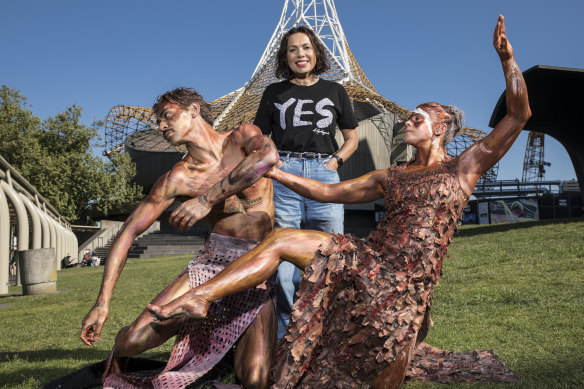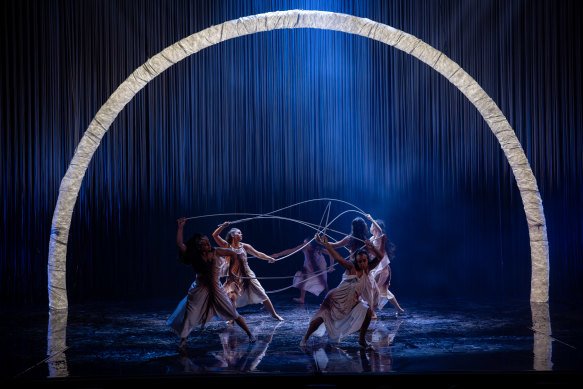Save articles for later
Add articles to your saved list and come back to them any time.
To make Yuldea, her first work as artistic director of Bangarra Dance Theatre, Frances Rings went back to the source – in every sense.
Yuldea is the name of a sacred water source in the desert of south-western South Australia, and the site of the town of Ooldea, which sprang up in the early 20th century to support workers constructing the Trans-Australian Railway, which linked Port Augusta in the east to Kalgoorlie in the west. It is also a place seared into her own family history.
Bangarra artistic director Frances Rings, centre, with dancers Daniel Mateo and Kassidy Waters.Credit: Sam Tabone
“My father worked on the railways, so I grew up hearing railway stories,” says Rings. “My mother’s from the far west coast of South Australia, my grandfather’s from the Nullarbor region, and my grandmother comes from an area north of Yuldea.
“I feel like these stories have been orbiting around me all my life, and as a storyteller, and a mother myself, I wanted to find out more about the history.”
Yuldea is a soak, rather than a standing body of water. Its riches need to be unearthed, and so are bound in knowledge of country. It was for millennia a vital place for the peoples of the desert to meet, to eat and to trade.
In researching the piece, Rings and her creative team travelled to the area, and heard from a cultural astronomer about a constellation called the Pleiades or Seven Sisters. “But it only has five stars,” she says. Aboriginal people had lived in the area for so long, she says, “that people over time saw the birth and death of stars”.
In 1875, explorer Ernest Giles became the first European to discover the soak. In 1905, construction commenced on the railway, a great Federation-building project that aimed to connect the far-flung states into one country. And in 1917, the eastern and western parts of that project joined at Ooldea Siding.
There, a town had grown to support the construction workers. The underground water had been tapped to feed the thirsty steam engines that dragged what the indigenous people called the “metal serpents” across the land. The trees that kept the desert sands at bay had been cut down to make housing. When a fierce drought hit the area, the Indigenous people came out of the desert in search of less harsh conditions. By the 1930s, a mission had been set up on a former sheep station to “care” for the displaced community.
All of that, Rings says, “impacted on the availability of water”, and the soak was depleted. The culture that had thrived around the waterhole was in disarray, too.
And then came what she calls “the final act of displacement”, the atomic testing at Maralinga in the 1950s and ’60s.
“People were removed from Yuldea and sent in trucks north, south, east and west, displaced into missions around South Australia and Western Australia as well,” she says.
All of this is told – or, perhaps more accurately, evoked – in Yuldea. It’s a remarkable work of movement, sound and light, with an electronic score (from composer Leon Rodgers, with contributions from Electric Fields) and a minimalist set that features a curved fringe of ropes and a giant hovering white arc, sometimes positioned on the horizontal axis, sometimes on the vertical.
It is meant to represent a boomerang, says Rings. It is, she says, “a symbol of hope that wherever you were, wherever you would go, you would always be called back to your home, back to your country.”
It represents more than that, of course. The U shape is used in Indigenous art to suggest a gathering of people. And at times, as the arc hangs low above the stage, mirrored in the glossy black surface of the floor, it seems to suggest the reflecting edge of a body of water; at others, it could be the metal serpent itself.
“For different people, it speaks a different story,” Rings says. “And I love that.”
The arc centrepiece of the Yuldea set represents a boomerang, a symbol of return.Credit: Daniel Boud
As with all Bangarra work, the story was born on and informed by country, with permission to share it being sought and granted by those who are custodians of those tales.
“When I hear those stories, I’m like a sponge, I’m taking all of that in, I’m feeling it, and I’m seeing it,” says Rings. “It’s really visceral for me, it’s all there, I just have to get to the studio and collaborate with the dancers.”
Late next year, Bangarra will take the work back to the area in which it was conceived. There’ll be workshops, a feast, mob bused in from remote communities and bused back home afterwards, and, of course, the performance itself.
“It’s the process we use to work with a community to create a work and then return that work to community at the end,” Rings explains. It’s the crowning element in the creative life cycle that informs every piece of work the company creates.
“It’s the most important performance we’ll ever do of Yuldea,” Rings says of this homecoming. “It’s the full boomerang.”
Yuldea is at Arts Centre Melbourne until Saturday October 7, and at Ulumbarra Theatre, Bendigo from October 13-14. Details: bangarra.com.au
Contact the author at [email protected], follow him on Facebook at karlquinnjournalist and on Twitter @karlkwin, and read more of his work here.
Most Viewed in Culture
From our partners
Source: Read Full Article


